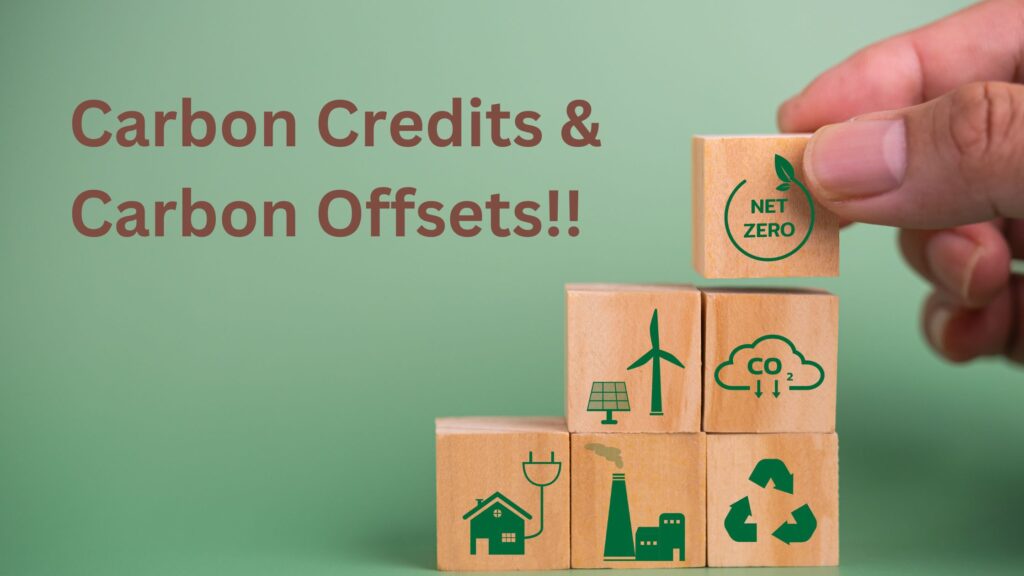We humans hold the right for a safe, clean, healthy and sustainable environment. However, climate change is threatening the enjoyment of our rights. Human-induced climate change is one of the 21st century’s biggest challenges. Nearly everything that makes our lives simpler or more convenient can contribute to climate change. Whether that’s driving your vehicle, processing your drinking water, or just charging your phone, all these actions produce carbon emissions. We all know it’s best to avoid creating CO₂ emissions, however, there are many such activities that contribute to unavoidable carbon emissions. Now, what do we do?
The answer lies in the term called “Carbon Credits & Carbon Offsets”. What are these? How are they beneficial?
What are Carbon Credits and its benefits? Carbon credits are permits that allow the owner to emit a certain amount of carbon dioxide or other greenhouse gases. One credit permits the emission of one ton of carbon dioxide or the equivalent in other greenhouse gases.


These permits are tradable and helps in putting a cap on countries /legal entities to emit carbon within a particular limit.
Let’s say that a developed country is allowed to emit only 100 tonnes of carbon, however they require 200 tonnes of carbon emission and the same cannot be reduced. There are few ways by which they can achieve their goal:
- Adopt a new technology to reduce CO2 emission; or,
- Improve existing technology to reduce CO2 emission; or,
- Tie up with a developing country
Now let’s say, a developing country is permitted to emit 1000 tonnes of carbon, but they have emitted only 900 tonnes and are left with 100 tonnes, unused. This means that the developing country has gained 100 carbon credits for saving 100 tonnes of carbon emission. In such cases, these 100 carbon credits can be traded with a developed country who is in requirement of additional tonnes of carbon emission in exchange of money or technology or both, to save more carbon emission. This process is called as Credit Carbon Trading.
Currently, India and China are the biggest sellers of carbon credit whereas countries in Europe are the biggest buyers. By entering carbon markets, developing countries can advance their socio-economic development while transitioning to a low-carbon economy in a cost-effective way.
How to Buy and Sell Carbon Credits?
Buying and selling carbon credits is a simple process conducted by individuals or companies. But like other markets, the price and value of these credits can fluctuate based on supply, demand, project type, and various other factors. Most buyers and sellers choose to use a carbon trading platform. These platforms make it easier for everyone to negotiate prices, so all can benefit financially from reducing carbon footprint.
Carbon markets make it possible for companies to take steps to reduce greenhouse emissions and make some money in the process. This is essentially a cash-incentive for saving the planet. If your business, non-profit, or enterprise is actively reducing the amount of greenhouse emissions, then it’s possible to turn your efforts into valuable funding.
How Indian Farmers can benefit from Carbon credits?
Poor soil health and decreasing profits plague Indian farmers. Selling carbon credits might be the opportunity that addresses these problems. But to achieve carbon credits, farmers need to ensure their soil health time to time.
Soil carbon sequestration is a process by which the air’s carbon dioxide is extracted and stored in a soil carbon pool. During photosynthesis, plants break down carbon dioxide and water from the atmosphere into oxygen, sugar, and carbon-rich compounds. These reach the roots and the soil underneath and nourish the organisms below the soil. However, the reduction of biomass below the soil, increased soil erosion, and higher tilling causes a higher percentage of carbon dioxide to be released back into the air, which leaves the soil with reduced carbon content.Now to restore soil’s health, farmers should follow certain practices, which will help reduce the loss of carbon from soil.
- Cover cropping to keep the land covered at all times.
- Residue mulching and recycling the soil’s biowaste.
- Manure, compost, and biofertiliser usage.
- Better crop rotations and intercropping.
- Reducing flood irrigation and chemical use.
When farmers follow these practices for a few seasons, the carbon content of soil improves. As a result, the yield also increases. However, farmers may need an incentive to adopt these practices as they can be time-consuming and expensive, and unremunerative in the short term. The ability to trade carbon credits at voluntary carbon markets can serve as this incentive. The direct benefit is that farmers receive cash-based incentives for the carbon they have helped sequester in their lands.
A farmer who sequesters one carbon credit can earn approximately INR 780 at current market prices, but large corporations are likely to provide better rates—as high as INR 2,000—to farmers when directly purchasing large chunks of carbon credits. In our experience, farmers who follow regenerative practices are able to sequester one to four carbon credits per acre.


Now what is Carbon Offsetting? Carbon offsetting is pretty straightforward. Entities that emit carbon or other greenhouse gas(GHG) emissions can pay for initiatives such as planting trees or regenerative agriculture, that removes carbon from the atmosphere. As a result, their emissions get reduced or cancelled out, at least in theory. If enough companies, governments, and individuals commit to offsetting their emissions, then global warming could theoretically be stopped, because for every emission released into the atmosphere, someone would be paying to have it offset.
Carbon offset programs allow governments, companies, and individuals to minimize their environmental impact.
UN has created platform for the carbon offset activities, called United Nations Carbon Offset Platform. It is an e-commerce platform where a company, an organization or a regular citizen can purchase units (carbon credits) to compensate greenhouse gas emissions or to simply support action on climate (Carbon offset).
A key element of the platform is the carbon footprint calculator for individuals. This calculator is built as a simple questionnaire, where you will provide information about your activities and obtain an estimation of the amount of your emissions as a result (i.e., your carbon footprint).
Planting trees is foundational to carbon offsetting. Here are just a few terms that describe different strategies to offset carbon pollution with trees:
- Afforestation: Afforestation is planting trees in a spot that previously didn’t have them in order to fight environmental challenges.
- Reforestation: Reforestation is planting trees where forests have been clear cut or deforested, trying to bring back or revitalize a habitat that humans decimated.
- Avoided Deforestation: Avoided deforestation is giving incentives to landowners to keep forests intact when they could otherwise clear land for agriculture and other profit.
Other carbon offset projects could be
- Investing in renewable energy technologies like Hydropower, Solar power, Tidal power, Wind power, Biomass Power and Geothermal Power for modern lives.
- Improving energy efficiency across the world
- Capturing carbon from the atmosphere and using it to create biofuel.
Now coming back to the Credit carbon trading and Carbon markets, there have been criticism on the functioning of these markets, which needs attention. Some of them highligted below :
- There are concerns regarding the effectiveness of carbon markets in curbing emissions. Some companies simply buy credits without making any effort to reduce emissions themselves. It is cheaper for them to buy carbon credit than to invest in emission reducing technologies.
- Environmental activists argue that only high-quality carbon offsets are effective in reducing emissions, i.e. they should be audited for real carbon offset, should be permanent and never reversed and companies should be sustainable without having credit carbon markets.
- Buying carbon credits can deviate the rich nations from the path of reducing emissions.
- It is difficult to establish the amount of carbon reduced by offset projects (like afforestation or wind energy project).
The establishment of a domestic carbon market is a progressive step. However, the actual benefit will depend upon the effectiveness of the market and for this, the Government must ensure that proper regulations are established and there must be periodic assessment of its functioning.
To summarize, Carbon credits were devised as a mechanism to reduce greenhouse gas emissions by creating a market in which companies can trade in emissions permits. Under the system, companies get a set number of carbon credits, which decline over time. They can sell any excess to another company.
Carbon credits create a monetary incentive for companies to reduce their carbon emissions. Those that cannot easily reduce emissions can still operate, but at a higher financial cost.
Now the question is, how can we contribute to Carbon offset actions in our day to day lives? Giving this a thought, the best way to reduce your environmental footprint is simply to avoid emissions-intensive activities in the first place, which means eating less meat, flying less often, using public transportation, and ensuring that your home gets its electricity from renewable sources of energy and last but the not the least…Let’s all plant trees as
“Planting a tree a day helps keep emissions at bay”
Above catchy motto certainly encourages action that can do a whole lot of good. Every little bit counts. Even one tree counts!!
Where does India stand with respect to Carbon Credit Market?
India in last September emerged as one of biggest sellers of Carbon Credits! In Dec 2022, Rajya Sabha passes Bill to set up carbon credit trading scheme. As per India’s commitments under the United Nations Framework Convention on Climate Change as given by Prime Minister Narendra Modi at COP-26 last year, the goal is to cut carbon emission intensity by 45% and achieve 50% of the installed capacity of electricity generation from non-fossil fuel sources.
“The carbon market is expected to become the world’s biggest commodity market and looking to be a trillion- dollar industry very soon.”
~ New York Times






